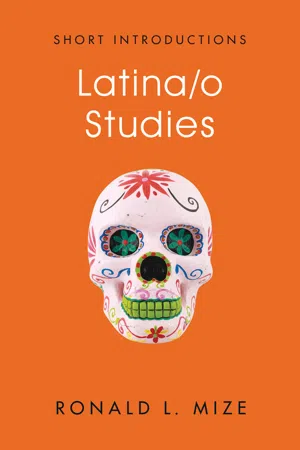1
What's in a Name? Hispanic, Latino: Labels, Identities
“What's in a name?” The eternal question, asked by Juliet Capulet, was first penned by William Shakespeare and makes a link among naming, nature, and human sensation, by describing a rose that “by any other name would smell as sweet.” Quite ironically, Juliet's and Romeo Montague's deaths are testaments to the importance of naming, as the significance of their feuding last names sets into motion a whole series of mishaps and misunderstandings leading to their untimely deaths.
For scholars in Latina/o Studies,1 “what's in a name” is a longstanding question in the field (see Gutiérrez 2016, Mora 2014, Oboler 1995, Rodríguez 2000, Rumbaut 2009). In their2 classic on “ethnic labels,” Suzanne Oboler (1995: 166) notes “the names adopted by different groups or imposed on them by others emerge as a result of particular historical and political contexts.” Ramón Gutiérrez (2016) asks the question explicitly to begin The New Latino Studies Reader.
To whom are we referring when we speak of Latinos? Currently, the US government defines Hispanics or Latinos as an ethnic group, “who trace their origins to Spain … Hispanic origin can be viewed as the heritage, nationality, lineage, or country of birth of the person or the person's parents or ancestors before arriving in the United States. People who identify as Hispanic, Latino, or Spanish may be any race.”3
The US government created the term “Hispanic” to group together Puerto Ricans, Mexicans, and to a certain extent Cubans in their enumeration. For Puerto Ricans and Mexicans, the accounting related to civil rights legislation that provided protections for those subject to racial discrimination in housing, education, voting rights, and public accommodations. Fleeing Castro's communist regime, Cubans were enumerated for the purposes of extending refugee status and state subsidies to help exiles regain their economic footing in South Florida. Those included in the Hispanic category grew over time to also encompass Central Americans, South Americans, and Caribbeans whose national origin could be traced to Spanish colonization.
The purpose of chapter 1 is to provide clarity to the labeling and identity processes that inform Latino/a Studies. Partially an explication of keywords, partially a map of the field, this chapter explores the labels deployed (Hispanic, Latino, Puerto Rican, Mexican American, Chicano, etc.) alongside the identities they represent. I will discuss not only definitions imposed by the US Census but also emerging identities explored by Latina/o Studies scholars, including Latinidades, transnational, Indigenous, Afro-Latino, Asian Latino, Latino/a, Latin@, and Latinx identities.
Constructing Hispanics
In Latina/o Studies, the construction of the Hispanic category has been traced both in the context of how the US Census measures race in historically variant ways to serve larger political ends and also in terms of how the 1980s was deemed the “Hispanic decade,” by viewing Census constructions in relation to Spanish-language media and Hispanic advocacy organizations. Clara Rodríguez (2000) traces the history of how race was historically defined by the US government within the Black/White binary to explain why the recent construction of the Hispanic category is defined by the Census as an ethnic, not racial, distinction. More recent analyses look beyond the Census to identify how “the Hispanic category became institutionalized as bureaucrats, activists, and media executives forged networks and worked together to build panethnic organizations that popularized the notion of a Hispanic identity” (Mora 2014: xiii).
The creation of the Hispanic label is a US government invention for the purposes of enumerating a specific subgroup of the US population. Officially designated in the Office of Management and Budget's (OMB) Directive 15, the 1977 directive has a longer history – in particular, the US Census’ role in naming Hispanics. In the pursuit of equal rights, the collection of racial statistics after 1960 was designed to determine status eligibility for civil rights protections and affirmative action participation. “Drawing on the categories employed in a 1950 government form, the Equal Employment Opportunity Commission (EEOC) in 1964 identified four minority groups: Negro, Spanish-American, American-Indian, and Asian” (Prewitt 2005: 8). Yet in the same decade, the US Census categorized all Latinos as White. “In the 1960 census, enumerators were instructed to record: Puerto Ricans, Mexicans, or other persons of Latin American descent as ‘White’ unless they were definitely of Negro, Indian, or other non-white race” (Bennett 2000: 172).
The discrepancy between being categorized as simultaneously a minority and part of the majority was not fixed in the decade between 1960 and 1970, even though there was a shift from imputation to self-identification. This was not done for noble reasons of racial accuracy and self-clarification; in reality there were many more mail-surveys distributed in the 1970 Census (approximately 70 percent of households received mail-in questionnaires), and thus, direct enumeration was next to impossible. The history, from 1790 to 1960, of enumerators determining the race of respondents was officially over.
In 1970, the questionnaires remained essentially the same as in 1960 but respondents were asked to choose their race. Only one circle could be filled in. For Latinos, the only applicable bubble was “other” unless they self-identified as Black, White, American Indian, of certain Asian national origins, or Hawaiian. It was not until the passage of Public Law 94-311 in 1976 that US Congress specified rules “relating to the publication of economic and social statistics for Americans of Spanish origin or descent.”
Signed by President Gerald Ford in June 1976, it remains the only law in the country's history that mandates the collection, analysis, and publication of data for a specific ethnic group, and goes on to define the population to be enumerated. The law, building on infor...
